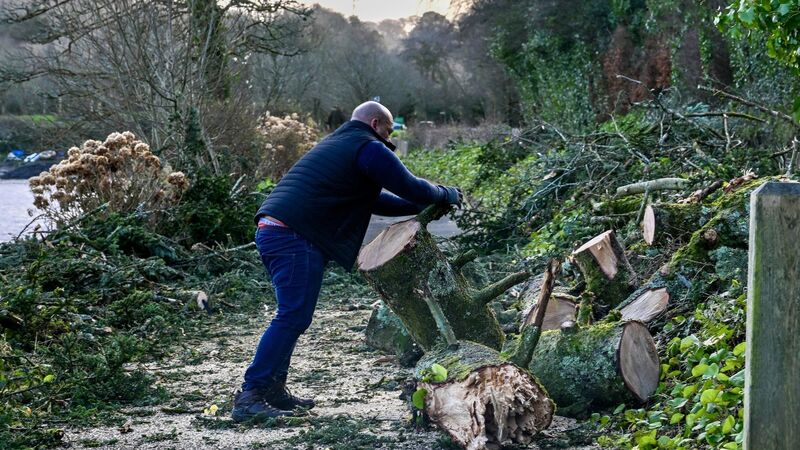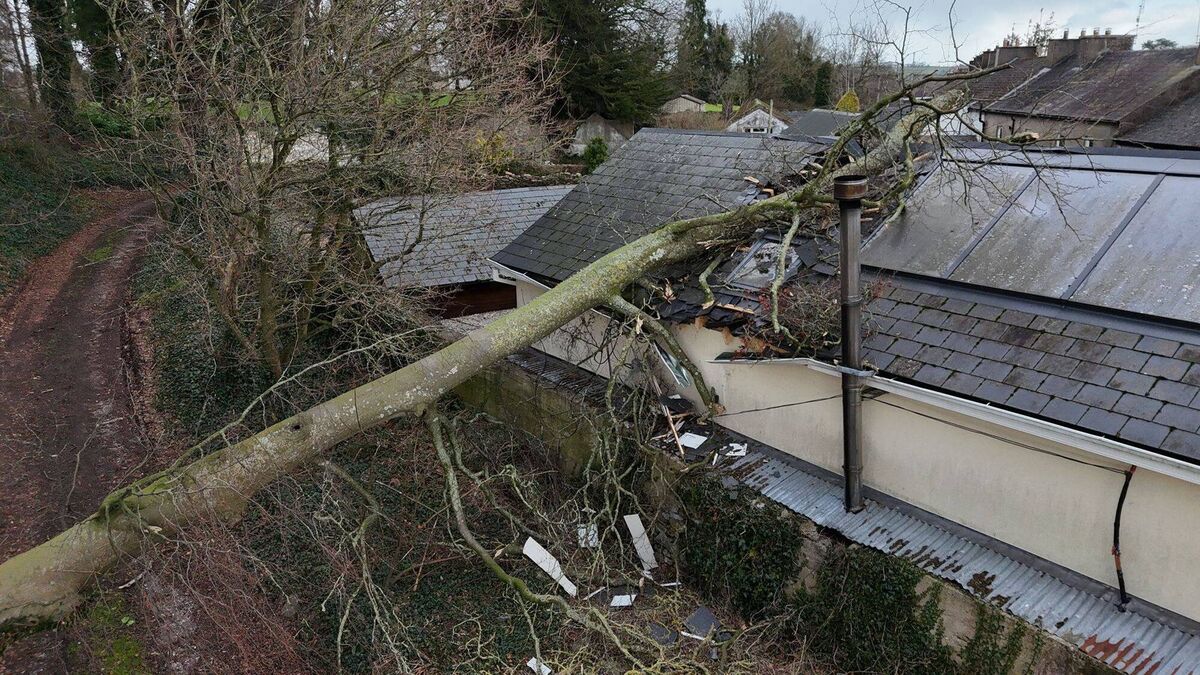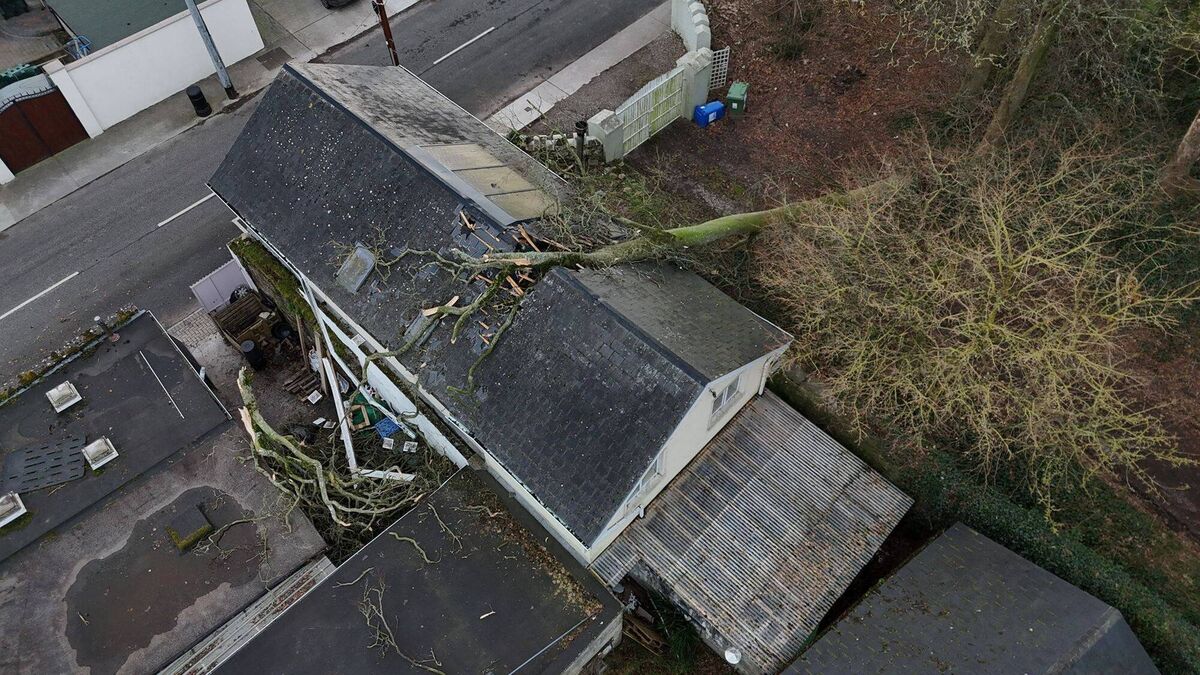We can't stop storms coming but we can be more ready for them

A tree felled by storm Éowyn in Crosshaven is cleared by a local crew from MTS. Picture: Chani Anderson
Storm Éowyn rampaged across the country, tearing down mature trees in parks and gardens, along roadsides and from within woodland, as well as uprooting enormous swathes of commercial forestry. Images of fallen trees across roads make for dramatic news coverage, especially when blocking roads or crushing buildings.
In nature, storms are a prime agent of regeneration in woodland ecosystems. A healthy deciduous woodland, the natural climax cover of most of Ireland, will always contain plentiful saplings and young trees, each awaiting the opportunity of a gap to opening up in the canopy.
We now know, through research about the extent of underground ‘communications’ between trees, that as these young trees await their turn, mature ‘mother’ trees can supply them with carbon and nitrogen though subterranean mycorrhizal networks, helping to help sustain young trees in shady conditions. In this way, saplings can spend years, or even decades, as twiggy little trees with only a few leaves, their age being much more than their small size would suggest.

When storms blow down old or mature trees in a woodland, gaps are opened in the canopy, presenting an opportunity for well positioned saplings to take their place among the canopy trees.
Of course, when there are too many grazing deer or goats, the saplings all get nibbled and regeneration is stifled. Mimicking such natural systems is how we can plan for resilience in the future.
Sitka Spruce too many, too close, too costly impacting on many and all aspects of life in our communities. STOP plan for #communitiesnotconifers @ppnleitrim pic.twitter.com/Rk4tWnRVQP
— Save Leitrim (@SaveLeitrim) January 27, 2025
Increasing storminess poses a huge threat to the viability of woodlands, parkland trees and hedgerow trees. In such situations, it is up to the human managers of these systems to allow for a continuous cohort of young trees ready to replace mature trees when they fall.
Another aspect that we often overlook is the crucial role of dead wood in a woodland ecosystem. Every twig and branch that falls to the ground in a woodland is recycled by an array of decomposers, among them some rare creatures that require continuity of dead wood to survive. Tiny toadstools establish themselves on scattered branches and colourful fungi emerge in abundance from fallen logs. Sawflies and other invertebrates depend on a continuity of supply of deadwood too. Over time, wood is broken down by specialist decomposers into valuable nutrients that are taken up by soil organisms and are eventually recycled into new growth in surrounding plants and trees.
With our appetite for tidiness and order, we humans have normalised the removal of fallen wood from parks and woodlands. It is now widely recognised that fallen dead wood is better left to be broken down in situ, habitat in itself for many woodland creatures. Wherever possible, leave fallen wood in situ where it will provide valuable wildlife habitat.
The destruction caused by big storms in plantation forests is another matter altogether. Much of the Sitka spruce plantations in Ireland have been planted on shallow, peaty soils, so the root platelets, especially with Sitka Spruce, are broad and shallow. This leaves mature spruce plantations exceptionally vulnerable to windthrow. Storm Éowyn has caused enormous damage to forestry plantations across Ireland, with pictures appearing in newspapers and social media showing how entire hillsides of spruce have been flattened by record winds. In 2014, during Storm Darwin, described as a 1 in 20-year storm event, more than 8,000 ha of plantation forests were damaged. Multiple record-breaking storms have occurred since then, yet the damage to forestry plantations from Storm Éowyn is expected to exceed all previous records.

Storm damage has major economic as well as environmental consequences. Financial losses for forest owners and investors go beyond the loss of timber, as lower timber prices typically follow such storms and harvesting costs in the aftermath will be higher too. Environmental impacts arise when the upturned root platelets leave soil highly disturbed and open to be washed from sloping sites into streams and rivers.
There the soil particles clog up gravel beds that salmon and trout need for spawning as well as smothering essential aquatic invertebrates. As many of the forest plantations on peaty soils have been sprayed with fertilisers to enhance growth, these fertilisers too get washed into waterways when windthrow breaks up the soil, causing nutrient enrichment and associated oxygen depletion in waterways too.
It is well understood now that Ireland will continue to experience increases in extreme wind speeds and storm events as a consequence of climate change. It makes no sense, that with such increasing vulnerability, the national approach to forest management is not also changing dramatically.
One of the most promising and most overlooked adaptations is a switch to ‘Continuous cover forestry’ (CCF), also known as ‘close to nature silviculture’. These are a set of approaches to forest management that mimic natural woodland dynamics in order to increase economic as well as environmental benefits of forestry.
CCF stands tend to have an assortment of tree species and diversity of age and structure too, so windthrow doesn’t occur to the same extent that it does in vast monocultures of spruce that are still the norm across Irish uplands. In addition to being a great deal more resilient to storm damage, forests managed in accordance with these principles are also more resilient to pests and diseases.
Initiatives across Europe, and to a lesser extent in Ireland, have developed techniques for conversion of conifer plantations to mixed CCF stands and demonstrated positive economic as well as environmental results.
Because there is always an overhead canopy and less ground disturbance, continuous cover approaches make for physically more robust forests, with far more opportunities for biodiversity and an increase the amount of carbon stored within the forest.
There are so many known benefits of CCF and close to nature silviculture, it is a wonder that the forest industry is still so attached to outdated, environmentally damaging forestry across Ireland, especially seeing how vulnerable such stands are to storm damage. Even on purely economic grounds, the high risk of storm damage in spruce plantations produces high levels of uncertainly for investment returns.
It will take some time before the damage to forestry from Storm Éowyn is assessed. But in responding to the increasing frequency and severity of such storms, Ireland must do more to support the transition to continuous cover forest management methods, including boosting the training and advice available to foresters and structuring the funding opportunities for forest owners to encourage conversion. Programming for resilience is key.








